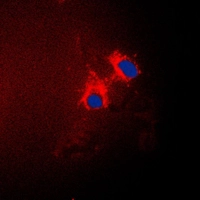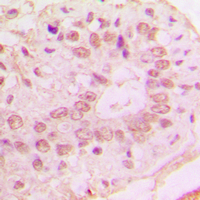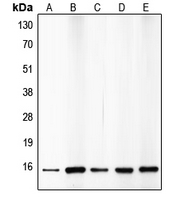
ICC/IF analysis of formalin-fixed A549 cells using GTX55855 p15 INK4b antibody. Red : Primary antibody Blue : DAPI Permeabilization : 0.1% Triton X-100 in TBS for 5-10 minutes
p15 INK4b antibody
GTX55855
ApplicationsImmunoFluorescence, Western Blot, ImmunoCytoChemistry, ImmunoHistoChemistry, ImmunoHistoChemistry Paraffin
Product group Antibodies
ReactivityHuman, Mouse, Rat
TargetCDKN2B
Overview
- SupplierGeneTex
- Product Namep15 INK4b antibody
- Delivery Days Customer9
- Application Supplier NoteWB: 1:500 - 1:1000. ICC/IF: 1:100 - 1:500. IHC-P: 1:100 - 1:200. *Optimal dilutions/concentrations should be determined by the researcher.Not tested in other applications.
- ApplicationsImmunoFluorescence, Western Blot, ImmunoCytoChemistry, ImmunoHistoChemistry, ImmunoHistoChemistry Paraffin
- CertificationResearch Use Only
- ClonalityPolyclonal
- ConjugateUnconjugated
- Gene ID1030
- Target nameCDKN2B
- Target descriptioncyclin dependent kinase inhibitor 2B
- Target synonymsCDK4I, INK4B, MTS2, P15, TP15, p15INK4b, cyclin-dependent kinase 4 inhibitor B, CDK inhibitory protein, CDK4B inhibitor, MTS-2, cyclin-dependent kinase inhibitor 2B (p15, inhibits CDK4), cyclin-dependent kinases 4 and 6 binding protein, multiple tumor suppressor 2, p14-INK4b, p14_CDK inhibitor, p14_INK4B, p15 CDK inhibitor, p15-INK4b, p15_INK4B
- HostRabbit
- IsotypeIgG
- Protein IDP42772
- Protein NameCyclin-dependent kinase 4 inhibitor B
- Scientific DescriptionThis gene lies adjacent to the tumor suppressor gene CDKN2A in a region that is frequently mutated and deleted in a wide variety of tumors. This gene encodes a cyclin-dependent kinase inhibitor, which forms a complex with CDK4 or CDK6, and prevents the activation of the CDK kinases, thus the encoded protein functions as a cell growth regulator that controls cell cycle G1 progression. The expression of this gene was found to be dramatically induced by TGF beta, which suggested its role in the TGF beta induced growth inhibition. Two alternatively spliced transcript variants of this gene, which encode distinct proteins, have been reported. [provided by RefSeq, Jul 2008]
- ReactivityHuman, Mouse, Rat
- Storage Instruction-20°C or -80°C,2°C to 8°C
- UNSPSC12352203








